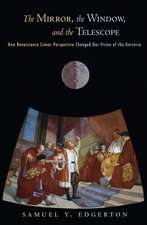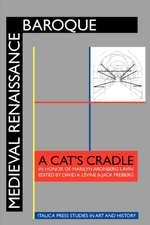Influences: Art, Optics, and Astrology in the Italian Renaissance
Autor Mary Quinlan-McGrathen Limba Engleză Paperback – 3 oct 2016
Today few would think of astronomy and astrology as fields related to theology. Fewer still would know that physically absorbing planetary rays was once considered to have medical and psychological effects. But this was the understanding of light radiation held by certain natural philosophers of early modern Europe, and that, argues Mary Quinlan-McGrath, was why educated people of the Renaissance commissioned artworks centered on astrological themes and practices.
Influences is the first book to reveal how important Renaissance artworks were designed to be not only beautiful but also—perhaps even primarily—functional. From the fresco cycles at Caprarola, to the Vatican’s Sala dei Pontefici, to the Villa Farnesina, these great works were commissioned to selectively capture and then transmit celestial radiation, influencing the bodies and minds of their audiences. Quinlan-McGrath examines the sophisticated logic behind these theories and practices and, along the way, sheds light on early creation theory; the relationship between astrology and natural theology; and the protochemistry, physics, and mathematics of rays.
An original and intellectually stimulating study, Influences adds a new dimension to the understanding of aesthetics among Renaissance patrons and a new meaning to the seductive powers of art.
Preț: 162.56 lei
Nou
Puncte Express: 244
Preț estimativ în valută:
31.11€ • 32.56$ • 25.89£
31.11€ • 32.56$ • 25.89£
Carte disponibilă
Livrare economică 10-24 martie
Livrare express 22-28 februarie pentru 25.68 lei
Preluare comenzi: 021 569.72.76
Specificații
ISBN-13: 9780226421667
ISBN-10: 022642166X
Pagini: 304
Ilustrații: 14 color plates, 12 halftones, 14 line drawings
Dimensiuni: 152 x 229 x 23 mm
Greutate: 0.41 kg
Editura: University of Chicago Press
Colecția University of Chicago Press
ISBN-10: 022642166X
Pagini: 304
Ilustrații: 14 color plates, 12 halftones, 14 line drawings
Dimensiuni: 152 x 229 x 23 mm
Greutate: 0.41 kg
Editura: University of Chicago Press
Colecția University of Chicago Press
Notă biografică
Mary Quinlan-McGrath is associate professor of art history at Northern Illinois University.
Cuprins
Preface
Introduction1. The Study of the Heavens Is Holy: The Cosmos, the Creator, Vision, and the Soul
2. Let There Be Light: Rays in the Macrocosm
3. Celestial Rays and the Earthly World of Change
4. The Physical Nature of Vision, the Material Image, and the Soul
5. Early Modern Ecosystems: The City, the Building, the Person
6. Architectural Theory and Astrological Foundations: Three Case Studies
7. The Hidden Power in a Picture: How Celestial Rays Are Trapped in Images
8. Look, Reflect, Be Changed: The Great Astrological Vaults of the Italian Renaissance
Conclusion
Acknowledgments
Notes
Bibliography
Index
Recenzii
“Influences is a meticulously well-researched, thoughtfully laid out book—an invaluable guide for students, teachers, and enthusiasts alike. . . . Quinlan-McGrath’s book accomplishes what successful art historical books set out to do: it clarifies a great deal of complex information in an engaging, accessible way as it enhances our understanding of the art and history of the Italian Renaissance.”
“This pathbreaking book brings the areas of theology, mathematics, science, art, philosophy, and optics under the umbrella of astrology and shows how they were understood as interrelated and informative practices during the Renaissance. . . . This book promises to be one of the most intensely discussed publications of all those concerned with human perception and the efficaciousness and inherently transformative nature of the visual object during the Renaissance. . . . Essential.”
“A richly detailed exposition that sheds new light on our understanding of the Italian Renaissance.”
“A clear, insightful, and unique assessment of the question of how the Renaissance dealt with the confluence of astronomy and astrology on the early side of any real scientific investigations of the heavens. Influences will be highly regarded by all interested students and scholars of the period. For those intrigued by the larger implications of Quinlan-McGrath’s study, it will be apparent that she has peered through a very interesting portal onto what is a growing interdisciplinary interest in understanding the intersection of spiritual and material reality.”
“A splendid synthesis of astrology, astronomy, optics, and theology that brings the art back to life. . . . This book will attract a wide audience of scholars and students with interests well beyond art history.”
“Compelling . . . [and] carefully researched. . . . The language is clear throughout the book and complex concepts on optics and mathematics are explained effectively. The book gives new significant insights into the mathematical, philosophical, and astrological cultures of the Renaissance and their application in pictorial works of the period.”
“The book is exceptionally well researched and meticulously documented. . . . Influences: Art, Optics, and Astrology in the Italian Renaissance is a truly significant and original contribution to the field of early modern studies.”
“Quinlan-McGrath’s fresh look at these astrological canopies opens up entire new vistas of Renaissance intellectual life. This alone makes it required reading for anyone interested in Renaissance visual culture, architecture, and history of natural philosophy. But it can also serve as a model of scholarship. Over the past few decades, it has become far less uncommon for art historians to sink their teeth into premodern intellectual history and history of science. Influences crowns them all in tenaciousness and thoughtfulness.”
“Quinlan-McGrath’s Influences is an eye-opener. If astrology was indeed everywhere in the Renaissance, as historians of astronomy have shown, there is no reason to assume that it was not in art and in image theories. Putting forward the original, daring, and timely thesis that astrology was indeed there, this book has the potential to be highly influential as it invites historians of art and science to reinvestigate the role of astrology in Renaissance image theories.”
"Influences: Art, Optics, and Astrology in the Italian Renaissance is stimulating for Quinlan-McGrath's praiseworthy effort to bring together theories too often studied separately (optics, natural philosophy, astrology, and visual art) in an attempt to expose a complete worldview that supports the understanding of Renaissance art 'images.' Unavoidably, such a global proposal entails singling out a few well-known authors and theories and hence sometimes leads to general reassessments; but, as the last chapter shows, her approach is fruitful and her analysis of Renaissance astrological vaults will shed new light on a long-discussed issue: the links between science, magic, and art in early modern Europe."
“Among the many virtues of this book, Mary Quinlan-McGrath brings two aspects of scholarship together in an innovative way. First, it is always difficult to explain to modern readers the fluid matter/spirit relation in an era well before Descartes. The idea that certain hidden, originally celestial qualities could impart long-lasting imprints onto materialized entities—and that those entities in turn could have real effects in the world—was shared to such an extent that it often did not have to be articulated. Second, Quinlan-McGrath brings this perspective into the context of patronage studies; this move represents something new in art historical scholarship. She presents a different way of understanding aesthetics and one that is much closer to what fifteenth- and sixteenth-century people experienced as they processed art. This sort of aesthetic appreciation was interactive, primarily, and assumed a fluid link between subject and object in a manner often unfamiliar today.”
“Astrology was everywhere in the Renaissance. Criticized, censored, and feared as the work of the devil, it nevertheless pervaded a wide spectrum of human activity. This book, ranging from Greek and Arabic science to some of the greatest works of Italian painting and architecture, explains the how and the why of astrology and helps us understand, even empathize with, a fundamental substrate of Renaissance art and thought.”
“Mary Quinlan-McGrath’s Influences is a work of striking originality. With unique clarity and expertise, she proves that Italian Renaissance architecture and visual arts were significantly influenced by a complex but coherent blending of astrology, Neoplatonic philosophy, geography, and other scientific disciplines. Quinlan-McGrath’s work is a truly significant contribution to the field of Renaissance studies.”
“This fascinating book is an original and intellectually stimulating synthesis of optical theory, astrological medicine, natural philosophy, psychology, theology, architecture, and painting that sheds new light on the deep cultural embeddedness of art in late medieval and Renaissance culture. Quinlan-McGrath breaks new ground, brings together fields that need to communicate more, and offers striking interpretations of Renaissance art by fleshing out the neglected intellectual presuppositions of its practitioners and patrons.”








